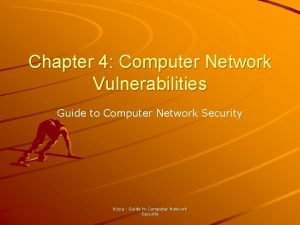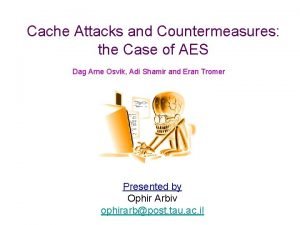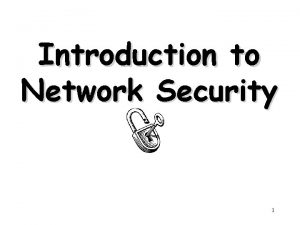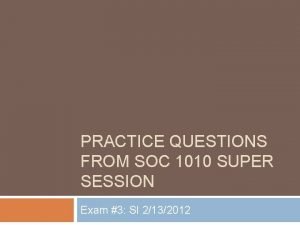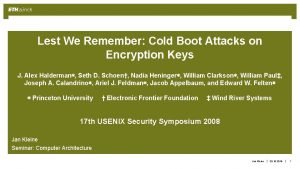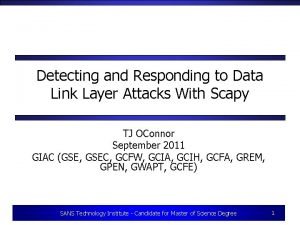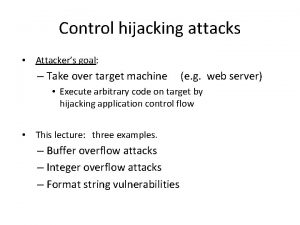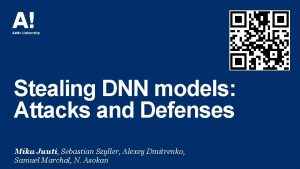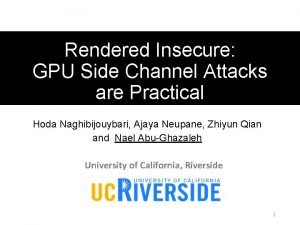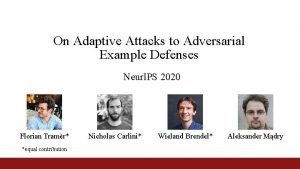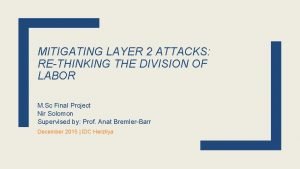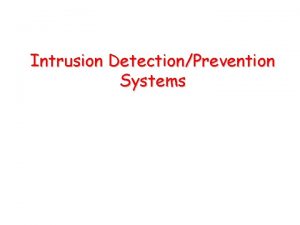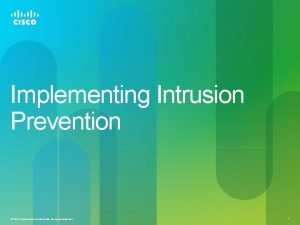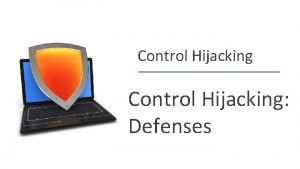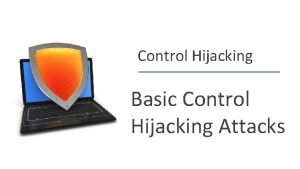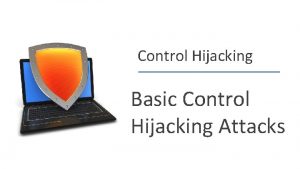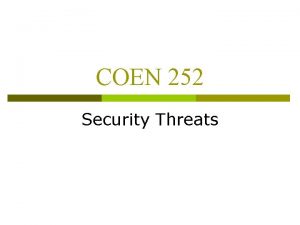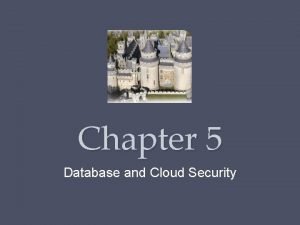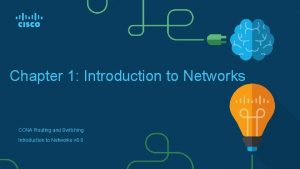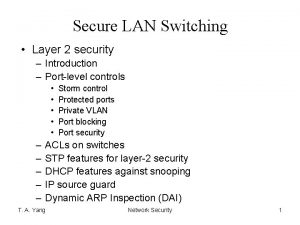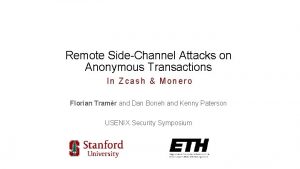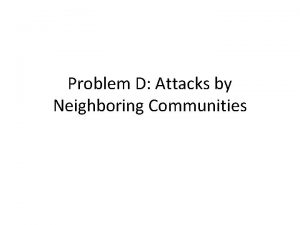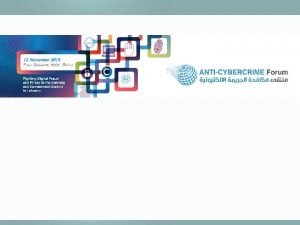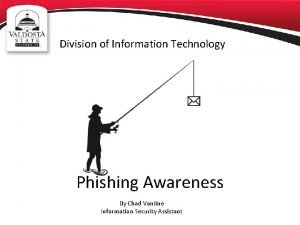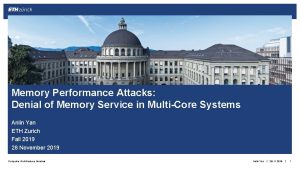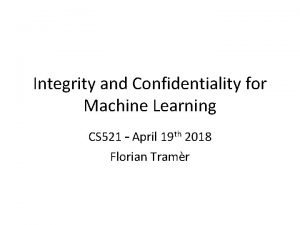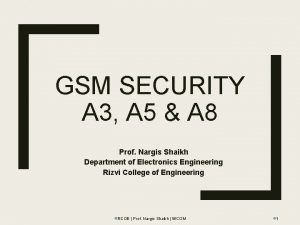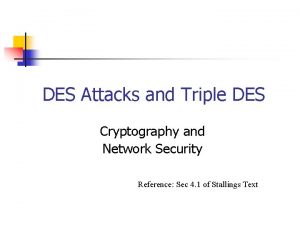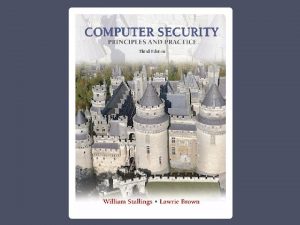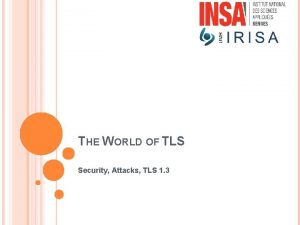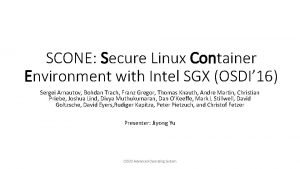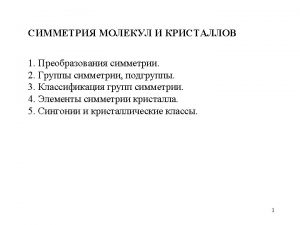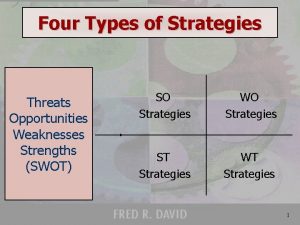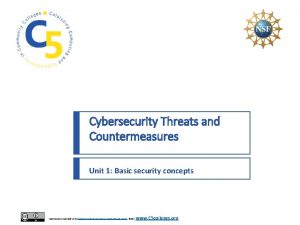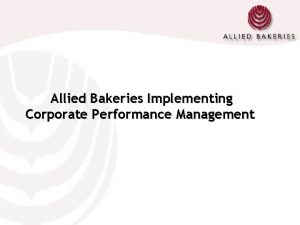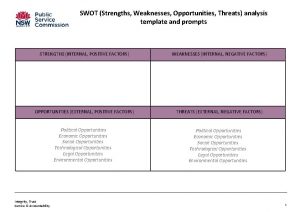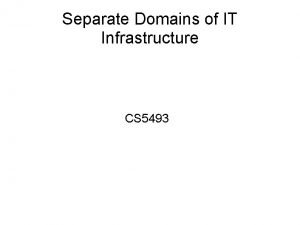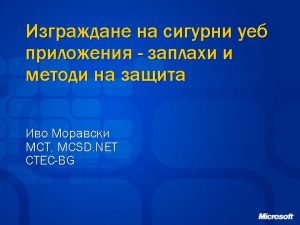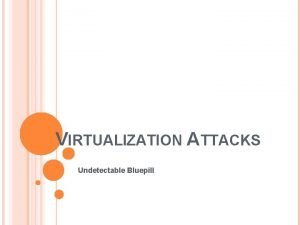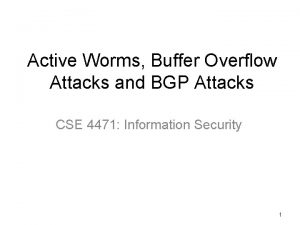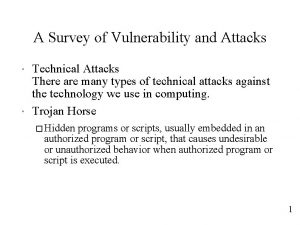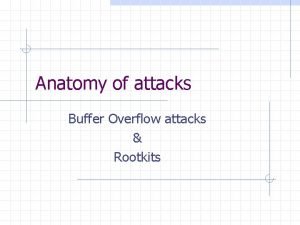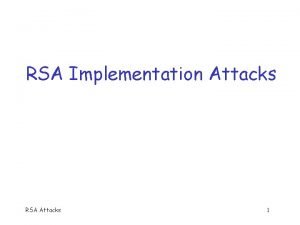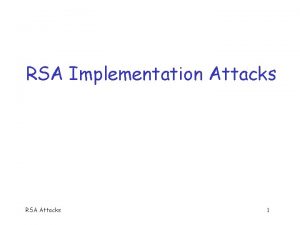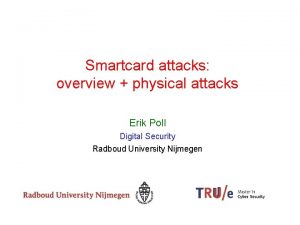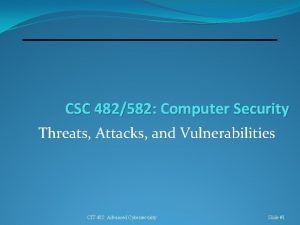1 Chapter 1 Threats 2 Threats and Attacks


























































- Slides: 58

1 Chapter 1 - Threats

2 Threats and Attacks • Eavesdropping: the interception of information intended for someone else during its transmission over a communication channel. Alice Bob Eve

3 Threats and Attacks • Alteration: unauthorized modification of information. –Example: the man-in-the-middle attack, where a network stream is intercepted, modified, and retransmitted. Sender encry pt plaintext M Communication channel shared secret key ciphertext C Recipient decry pt shared secret key Attacker (intercepting) ciphertext C′ plaintext M′

4 Threats and Attacks • Denial-of-service: the interruption or degradation of a data service or information access. –Example: email spam, to the degree that it is meant to simply fill up a mail queue and slow down an email server. Alice

5 Threats and Attacks • Masquerading: the fabrication of information that is purported to be from someone who is not actually the author. “From: Alice” (really is from Eve)

6 Threats and Attacks • Repudiation: the denial of a commitment or data receipt. –This involves an attempt to back out of a contract or a protocol that requires the different parties to provide receipts acknowledging that data has been received. Public domain image from http: //commons. wikimedia. org/wiki/File: Plastic_eraser. jpeg

7 Threats and Attacks • Correlation and traceback: the integration of multiple data sources and information flows to determine the source of a particular data stream or piece of information.

8 The Ten Security Principles Compromise recording Work factor Psychological acceptability Economy of mechanism Fail-safe defaults Security Principles Least common mechanism Least privilege Complete mediation Open design Separation of privilege

9 Economy of mechanism • This principle stresses simplicity in the design and implementation of security measures. –While applicable to most engineering endeavors, the notion of simplicity is especially important in the security domain, since a simple security framework facilitates its understanding by developers and users and enables the efficient development and verification of enforcement methods for it.

10 Fail-safe defaults • This principle states that the default configuration of a system should have a conservative protection scheme. –For example, when adding a new user to an operating system, the default group of the user should have minimal access rights to files and services. Unfortunately, operating systems and applications often have default options that favor usability over security.

11 Fail-safe defaults • This principle states that the default configuration of a system should have a conservative protection scheme. –This has been historically the case for a number of popular applications, such as web browsers that allow the execution of code downloaded from the web server.

12 Complete mediation • The idea behind this principle is that every access to a resource must be checked for compliance with a protection scheme. –As a consequence, one should be wary of performance improvement techniques that save the results of previous authorization checks, since permissions can change over time.

13 Complete mediation • The idea behind this principle is that every access to a resource must be checked for compliance with a protection scheme. –For example, an online banking web site should require users to sign on again after a certain amount of time, say, 15 minutes, has elapsed.

14 Open design • According to this principle, the security architecture and design of a system should be made publicly available. –Security should rely on keeping cryptographic keys secret. (Kerckhoff)

15 Open design • According to this principle, the security architecture and design of a system should be made publicly available. –Open design allows for a system to be scrutinized by multiple parties, which leads to the early discovery and correction of security vulnerabilities caused by design errors.

16 Open design • According to this principle, the security architecture and design of a system should be made publicly available. –The open design principle is the opposite of the approach known as security by obscurity, which tries to achieve security by keeping cryptographic algorithms secret and which has been historically used without success by several organizations.

17 Separation of privilege • This principle dictates that multiple conditions should be required to achieve access to restricted resources or have a program perform some action.

18 Least privilege • Each program and user of a computer system should operate with the bare minimum privileges necessary to function properly. –If this principle is enforced, abuse of privileges is restricted, and the damage caused by the compromise of a particular application or user account is minimized.

19 Least privilege • Each program and user of a computer system should operate with the bare minimum privileges necessary to function properly. –The military concept of need-to-know information is an example of this principle.

20 Least common mechanism • In systems with multiple users, mechanisms allowing resources to be shared by more than one user should be minimized. –For example, if a file or application needs to be accessed by more than one user, then these users should have separate channels by which to access these resources, to prevent unforeseen consequences that could cause security problems.

21 Psychological acceptability • This principle states that user interfaces should be well designed and intuitive, and all securityrelated settings should adhere to what an ordinary user might expect.

22 Psychological acceptability • Usability: • If it ain't usable, it ain't secure • Match mental models (understand meaning of policy in force) • Well-designed user interface (know what policy is in force)

23 Work factor • According to this principle, the cost of circumventing a security mechanism should be compared with the resources of an attacker when designing a security scheme.

24 Work factor • Example: –A system developed to protect student grades in a university database, which may be attacked by snoopers or students trying to change their grades, probably needs less sophisticated security measures than a system built to protect military secrets, which may be attacked by government intelligence organizations.

25 Compromise recording • This principle states that sometimes it is more desirable to record the details of an intrusion than to adopt more sophisticated measures to prevent it.

26 Compromise recording • This principle states that sometimes it is more desirable to record the details of an intrusion than to adopt more sophisticated measures to prevent it. –Internet-connected surveillance cameras are a typical example of an effective compromise record system that can be deployed to protect a building in lieu of reinforcing doors and windows.

27 Compromise recording • This principle states that sometimes it is more desirable to record the details of an intrusion than to adopt more sophisticated measures to prevent it. –The servers in an office network may maintain logs for all accesses to files, all emails sent and received, and all web browsing sessions.

28 Topic: Access Control • Users and groups • Authentication • Passwords • File protection • Access control lists 8/25/14 Introduction • Which users can read/write which files? • Are my files really safe? • What does it mean to be root? • What do we really want to control?

29 Access Control Matrices • A table that defines permissions. –Each row of this table is associated with a subject, which is a user, group, or system that can perform actions. –Each column of the table is associated with an object, which is a file, directory, document, device, resource, or any other entity for which we want to define access rights.

30 Access Control Matrices • A table that defines permissions. –Each cell of the table is then filled with the access rights for the associated combination of subject and object. –Access rights can include actions such as reading, writing, copying, executing, deleting, and annotating. –An empty cell means that no access rights are granted.

31 Example Access Control Matrix

32 Access Control Matrices • A table that defines permissions. –Problem: Table can be really big! –Ex: Unix system with 1000 users, 1000 groups: each process has ruid, rgid, euid, egid, or 10004 = 1 trillion domains –Same system has say 1000 files/folders per user, or 1 million objects (plus the other users and groups) –ACM has 1 million trillion cells. . –But there is lots of redundancy!

33 Access Control Lists • It defines, for each object, o, a list, L, called o’s access control list, which enumerates all the subjects that have access rights for o and, for each subject, s, gives the access rights that s has for object o. /etc/passwd root: r, w mike: r roberto: r backup: r /usr/bin/ root: r, w, x mike: r, x roberto: r, x backup: r, x /u/roberto/ /admin/ root: r, w, x roberto: r, w, x backup: r, x root: r, w, x backup: r, x

34 Capabilities • Takes a subject-centered approach to access control. It defines, for each subject s, the list of the objects for which s has nonempty access control rights, together with the specific rights for each such object. root /etc/passwd: r, w, x; /usr/bin: r, w, x; /u/roberto: r, w, x; /admin/: r, w, x mike /usr/passwd: r; /usr/bin: r, x roberto /usr/passwd: r; /usr/bin: r; /u/roberto: r, w, x backup /etc/passwd: r, x; /usr/bin: r, x; /u/roberto: r, x; /admin/: r, x

35 Role-based Access Control • Define roles and then specify access control rights for these roles, rather than for subjects directly. • Specify to which roles a user can bind a process • Level of indirection – manage access by roles – handles all users with that role and expresses the rationale for access (or no access).

36 Role-based Access Control Department Chair Administrative Manager Accountant Secretary Administrative Personnel Lab Manager System Administrator Lab Technician Backup Agent Technical Personnel Department Member Undergraduate TA Undergraduate Student Faculty Student Graduate TA Graduate Student

37 Cryptographic Concepts • Encryption: a means to allow two parties, customarily called Alice and Bob, to establish confidential communication over an insecure channel that is subject to eavesdropping. Alice Bob Eve

38 Encryption and Decryption • The message M is called the plaintext. • Alice will convert plaintext M to an encrypted form using an encryption algorithm E that outputs a ciphertext C for M. Communication channel Sender encrypt Recipient decrypt ciphertext plaintext shared secret key Attacker (eavesdropping) shared secret key

39 Encryption and Decryption • As equations: C = E(M) M = D(C) • The encryption and decryption algorithms are chosen so that it is infeasible for someone other than Alice and Bob to determine plaintext M from ciphertext C. Thus, ciphertext C can be transmitted over an insecure channel that can be eavesdropped by an adversary.

40 Cryptosystem 1. The set of possible plaintexts 2. The set of possible ciphertexts 3. The set of encryption keys 4. The set of decryption keys 5. The correspondence between encryption keys and decryption keys 6. The encryption algorithm to use 7. The decryption algorithm to use

41 Caesar Cipher • Replace each letter with the one “three over” in the alphabet. Public domain image from http: //commons. wikimedia. org/wiki/File: Caesar 3. svg

42 Symmetric Cryptosystems • Alice and Bob share a secret key, which is used for both encryption and decryption. Sender Communication channel encrypt Recipient decrypt ciphertext plaintext shared secret key Attacker (eavesdropping) Same key shared secret key

43 Symmetric Key Distribution • Requires each pair of communicating parties to share a (separate) secret key. shared secret n (n-1)/2 keys shared secret

44 Public-Key Cryptography • Bob has two keys: a private key, SB, which Bob keeps secret, and a public key, PB, which Bob broadcasts widely. –In order for Alice to send an encrypted message to Bob, she need only obtain his public key, PB, use that to encrypt her message, M, and send the result, C = EPB (M), to Bob then uses his secret key to decrypt the message as M = DSB (C).

45 Public-Key Cryptography • Separate keys are used for encryption and decryption. Communication channel Sender encrypt plaintext Recipient decrypt plaintext ciphertext plaintext public key private key Attacker (eavesdropping)

46 Public Key Distribution • Only one key is needed for each recipient private public n key pairs private

47 Digital Signatures • Public-key encryption provides a method for doing digital signatures • To sign a message, M, Alice just encrypts it with her private key, SA, creating C = ESA(M). • Anyone can decrypt this message using Alice’s public key, as M’ = DPA(C), and compare that to the message M.

48 Cryptographic Hash Functions • A checksum on a message, M, that is: • One-way: it should be easy to compute Y=H(M), but hard to find M given only Y • Collision-resistant: it should be hard to find two messages, M and N, such that H(M)=H(N). • Examples: SHA-1, SHA-256.

49 Message Authentication Codes • Allows for Alice and Bob to have data integrity, if they share a secret key. • Given a message M, Alice computes H(K||M) and sends M and this hash to Bob. Communication channel h message M Sender shared secret key 6 B 34339 4 C 66809 MAC Attacker (modifying) (attack detected) 4 C 66809 =? 87 F 9024 received MAC h computed MAC message M’ shared secret key Recipient

50 Digital Certificates • certificate authority (CA) digitally signs a binding between an identity and the public key for that identity.

51 Passwords • A short sequence of characters used as a means to authenticate someone via a secret that they know. • Userid: _________ • Password: _______

How a password is stored? User Password file Dog 124 hash function Butch: ASDSA 21 QW 3 R 50 E ERWWER 323 … …

Strong Passwords • What is a strong password –UPPER/lower case characters –Special characters –Numbers • When is a password strong? –Seattle 1 –M 1 ke 03 –P@$$w 0 rd –TD 2 k 5 sec. V 53

Password Complexity • A fixed 6 symbols password: • Numbers – 106 = 1, 000 –UPPER or lower case characters – 266 = 308, 915, 776 –UPPER and lower case characters – 526 = 19, 770, 609, 664 – 32 special characters (&, %, $, £, “, |, ^, §, etc. ) – 326 = 1, 073, 741, 824 • 94 practical symbols available – 946 = 689, 869, 781, 056 • ASCII standard 7 bit 27 =128 symbols – 1286 = 4, 398, 046, 511, 104 54

Password Length • 26 UPPER/lower case characters = 52 characters • 10 numbers • 32 special characters • => 94 characters available • 5 characters: 945 = • 6 characters: 946 = • 7 characters: 947 = • 8 characters: 948 = • 9 characters: 949 = 7, 339, 040, 224 689, 869, 781, 056 64, 847, 759, 419, 264 6, 095, 689, 385, 410, 816 572, 994, 802, 228, 616, 704 55

Password Validity: Brute Force Test • Password does not change for 60 days • how many passwords should I try for each second? – 5 characters: 1, 415 PW /sec – 6 characters: 133, 076 PW /sec – 7 characters: 12, 509, 214 PW /sec – 8 characters: 1, 175, 866, 008 PW /sec – 9 characters: 110, 531, 404, 750 PW /sec 56

Secure Passwords • A strong password includes characters from at least three of the following groups: • Use pass phrases eg. "I re@lly want to buy 11 Dogs!" 57

58 Social Engineering • Pretexting: creating a story that convinces an administrator or operator into revealing secret information. • Baiting: offering a kind of “gift” to get a user or agent to perform an insecure action. • Quid pro quo: offering an action or service and then expecting something in return.
 Malicious attacks threats and vulnerabilities
Malicious attacks threats and vulnerabilities Chapter 4 vulnerability assessment and mitigating attacks
Chapter 4 vulnerability assessment and mitigating attacks Cache attacks and countermeasures: the case of aes
Cache attacks and countermeasures: the case of aes Security attacks services and mechanisms
Security attacks services and mechanisms Rsa timing attack
Rsa timing attack Attacks on bilingualism represent an ethnocentric
Attacks on bilingualism represent an ethnocentric Lest we remember: cold boot attacks on encryption keys
Lest we remember: cold boot attacks on encryption keys Cross-container attacks
Cross-container attacks Karmetasploit
Karmetasploit Control hijacking attacks
Control hijacking attacks Hijacking attacks
Hijacking attacks Rendered insecure: gpu side channel attacks are practical
Rendered insecure: gpu side channel attacks are practical Hijacking attacks
Hijacking attacks Neur ips
Neur ips Layer 2 attacks
Layer 2 attacks Zero-day attacks
Zero-day attacks Zero-day attacks
Zero-day attacks Icd gangguan cemas
Icd gangguan cemas Hijacking attacks
Hijacking attacks Hijacking attacks
Hijacking attacks Hijacking attacks
Hijacking attacks Hijacking attacks
Hijacking attacks Untargeted cyber attacks
Untargeted cyber attacks A single countermeasure is sufficient for sqli attacks.
A single countermeasure is sufficient for sqli attacks. Zero-day attacks
Zero-day attacks Certified defenses for data poisoning attacks
Certified defenses for data poisoning attacks Baseband processor
Baseband processor Portlev
Portlev Remote side-channel attacks on anonymous transactions
Remote side-channel attacks on anonymous transactions Attacks from neighboring communities
Attacks from neighboring communities Mobi fish
Mobi fish Types of cyber attacks
Types of cyber attacks Types of phishing attacks
Types of phishing attacks Corresponding responsibility
Corresponding responsibility French and indian war
French and indian war Stealing machine learning models via prediction apis
Stealing machine learning models via prediction apis Memory performance attacks
Memory performance attacks Confidential machine learning
Confidential machine learning Cryptographic attacks
Cryptographic attacks Triple des meet in the middle attack
Triple des meet in the middle attack Categories of attacks
Categories of attacks Attacks on tls
Attacks on tls Intel sgx attacks
Intel sgx attacks Fluid attacks
Fluid attacks Wireless security threats and vulnerabilities
Wireless security threats and vulnerabilities Types of opportunities
Types of opportunities Cyber security threats and countermeasures
Cyber security threats and countermeasures Factbranch
Factbranch Swot analysis of a teacher
Swot analysis of a teacher Swot analysis for english teachers
Swot analysis for english teachers Opportunities media and information
Opportunities media and information Strengths opportunities threats weaknesses
Strengths opportunities threats weaknesses Virus and related threats
Virus and related threats 4 basic expenditure cycle activities
4 basic expenditure cycle activities Opportunity and threat
Opportunity and threat Swot analysis of school
Swot analysis of school 7 domains of it infrastructure
7 domains of it infrastructure Major threats to biodiversity
Major threats to biodiversity Grassland animals adaptations
Grassland animals adaptations

